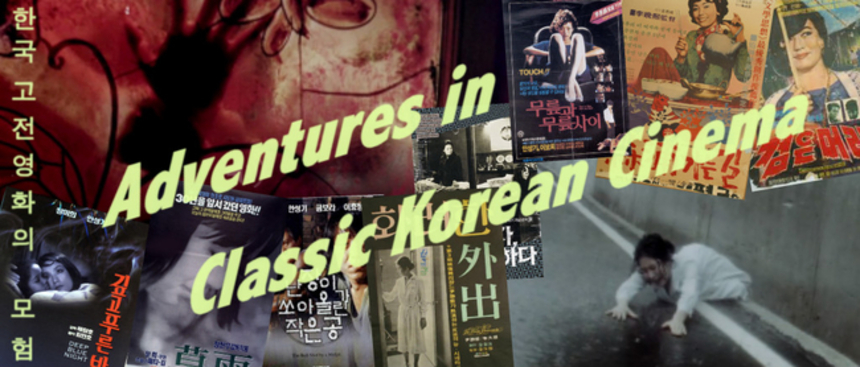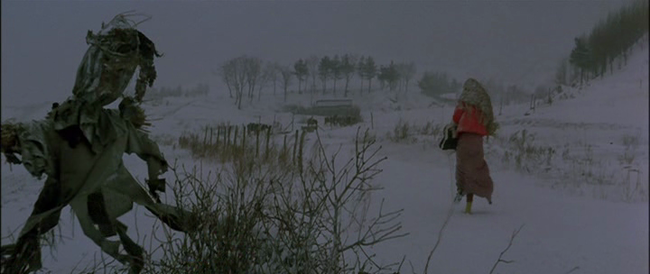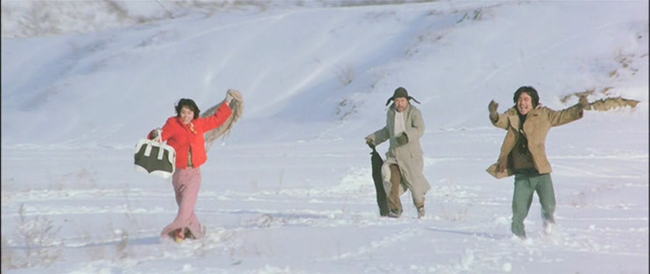Adventures in Classic Korean Cinema: THE ROAD TO SAMPO

A lot of people are talking about Korean Cinema these days. Whether it be the latest commercial blockbuster to gleefully experiment with genre or the freshest arthouse hit rocking the festival circuit, the industry has a built a well-earned reputation as one capable of satisfying a wide variety of cinematic tastes. However, as rich and diverse as today's Korean Cinema is, it didn't simply appear out of nowhere.
I've been watching Korean films for a decade and while I've seen my fair share of classics, particularly from the goldmine that is the 1970s, classic Korean Cinema has not exactly been my strong suit. Of late I've taken a greater interest in older Korean films and I'm very glad I have. With powerful dramas, demented genre pics, hot political potatoes, surprisingly erotic fare and much more besides, classic Korean Cinema, just like its modern incarnation, has something for everyone.
I'm enjoying myself so much with this bounty of little known Cinema that I'm eager to share it with anyone with a healthy curiosity towards world film. So please join me every second Thursday in my new regular feature, "Adventures in Classic Korean Cinema".
Keep in mind that my knowledge of these films and the eras in which they were made is somewhat limited, so forgive any mistakes or misjudgments in my commentaries. Also to clarify what I mean by classic Korean Cinema, this feature will cover anything from the birth of Korean film to the mid-1990s, right before the big boom that gave birth to the current industry.
THE ROAD TO SAMPO
Korea is not known for road movies and given that the country is smaller than many US states, this hardly comes as a surprise. Nevertheless, some of its most celebrated films take place on the road. Displaced characters have trudged along Korea's weather-beaten paths in search of a home in many a Korean film. Examples include Im Kwon-taek's Sopyeonje (1993), a mournful paean to the Pansori tradition (a style of sung folk narrative featuring a vocalist and a percussionist), and Lee Man-hee's ebullient swan song, The Road to Sampo (1975).
Lee's last work happens to be my first in his celebrated body of work. He was a Korean filmmaker credited with revolutionizing the Korean horror genre with Black Hair and The Devil's Staircase (both 1964) and responsible for a number of classics, including the oft remade Late Autumn (1966, no relation to the Ozu Yasujiro classic) and A Day Off (1968). By the mid-1970s, with his freedom as a filmmaker constricted and his health deteriorating, Lee was no longer producing at the same pace as his 60s output. Sadly, he died during the post-production of The Road to Sampo, one of the most irreverent films made during the darkest era of Korean filmmaking.
We meet the young brogue-ish builder Young-dal by a dilapidated construction site against a snow-white backdrop. He soon crosses paths with the middle-aged Jeong, who has just completed a ten-year jail sentence and is now starting on his journey back to Sampo, his hometown. Soon after, a young woman named Baek-hwa turns them into a wandering trio.
Essentially a series of vignettes punctuated with a little backstory, Lee's magnificent film is a unique and charming work unlike any other Korean film I've seen. The odd central trio, despite their unenviable predicaments, are full of life: particularly the bubbly Baek-hwa. Wearing a bright red jumper, she stands out starkly from the gorgeous snow-swept photography.
I was immediately taken with the film's beautiful vistas and it didn't take long before I became entranced by these beguiling and colorful vagabonds as they trudge along their road to nowhere. I was even more surprised when I noticed a number of parallels between The Road to Sampo and the films of Bong Joon-ho, my favorite Korean filmmaker. Those familiar with Memories of Murder (2003) will immediately recognize the dilapidated scarecrow by the side of the road that makes an appearance early on. A later scene, when our affable trio crashes a wake for a free meal, recalls The Host (2006), as Young-dal's theatrical tears make a mockery of a funeral.
Aside for Bong's affinity for black humor, I can't say for certain why he chose to reference this film (if this was indeed his intention) but in the case of the scarecrow it's possible that he was highlighting the dusty country road that bookends his most famous film. Korean Cinema has a long history of characters aimlessly wandering on roads. It's a potent symbol for the loss of home suffered by many following the Korean War, as the erection of a new border divided families. It can also be taken to represent emasculation or encroaching modernization. At one point in the narrative, the characters find themselves traipsing through the snow just beside a new highway that looms overhead. Despite their bonds, they also separate at a bus and train station near the end of the film, and when Jeong finally arrives in Sampo he finds that it is no longer the town he left behind.
In some ways Lee's film feels unfinished and there's no denying that it's very experimental and at times unbalanced. However, for the sheer affection it holds for its characters and for its confident, brazen approach to episodic storytelling, few road movies have been this much fun. The Road to Sampo is a minor masterpiece of Korean Cinema that has given me ample excuse to seek out the rest of Lee Man-hee's work.
The Road to Sampo is available on DVD, courtesy of the Korean Film Archive (KOFA). Don't dilly dally though as these KOFA reissues tend to go out of print quickly.







 (1)-thumb-80x80-93563.jpg)

